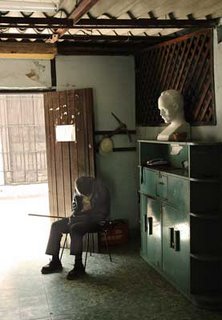 Old revolutionaries still hang around in Cuba. This was in the entrance to a boxing ring and training facility in Old Havana. I liked the entire scene-the light, the bust of Marti, and the old man asleep in his chair. I find the concept of revolution intriguing. All of us pass through a stage of revolt against authority. The USA would not exist if the early Patriots had not felt the urge to revolt against the heavy handed tactics of King George. I think it is what one does with the spoils of revolution that makes the real difference. The sudden changes and the threats of destroying so many people were a huge tactical error for the Castro regime after their successful revolution I think. The country was left with as group of amateurs to run it. It is no wonder the economy has failed. An allergist as Minister of Finance? Get real. (With apologies to some very smart allergists whom I know.)
Old revolutionaries still hang around in Cuba. This was in the entrance to a boxing ring and training facility in Old Havana. I liked the entire scene-the light, the bust of Marti, and the old man asleep in his chair. I find the concept of revolution intriguing. All of us pass through a stage of revolt against authority. The USA would not exist if the early Patriots had not felt the urge to revolt against the heavy handed tactics of King George. I think it is what one does with the spoils of revolution that makes the real difference. The sudden changes and the threats of destroying so many people were a huge tactical error for the Castro regime after their successful revolution I think. The country was left with as group of amateurs to run it. It is no wonder the economy has failed. An allergist as Minister of Finance? Get real. (With apologies to some very smart allergists whom I know.)
On the street in Havana you hear the young people greet each other with the phrase, "Que Bola?" this is equivalent to our US slang phrase "What's up?" This Cuba photo blog is morphing into my general blog with a wider scope of photos and commentary.This will enable me to keep my website clean and still have space to babble.
Tuesday, January 31, 2006
Old Men
 Old revolutionaries still hang around in Cuba. This was in the entrance to a boxing ring and training facility in Old Havana. I liked the entire scene-the light, the bust of Marti, and the old man asleep in his chair. I find the concept of revolution intriguing. All of us pass through a stage of revolt against authority. The USA would not exist if the early Patriots had not felt the urge to revolt against the heavy handed tactics of King George. I think it is what one does with the spoils of revolution that makes the real difference. The sudden changes and the threats of destroying so many people were a huge tactical error for the Castro regime after their successful revolution I think. The country was left with as group of amateurs to run it. It is no wonder the economy has failed. An allergist as Minister of Finance? Get real. (With apologies to some very smart allergists whom I know.)
Old revolutionaries still hang around in Cuba. This was in the entrance to a boxing ring and training facility in Old Havana. I liked the entire scene-the light, the bust of Marti, and the old man asleep in his chair. I find the concept of revolution intriguing. All of us pass through a stage of revolt against authority. The USA would not exist if the early Patriots had not felt the urge to revolt against the heavy handed tactics of King George. I think it is what one does with the spoils of revolution that makes the real difference. The sudden changes and the threats of destroying so many people were a huge tactical error for the Castro regime after their successful revolution I think. The country was left with as group of amateurs to run it. It is no wonder the economy has failed. An allergist as Minister of Finance? Get real. (With apologies to some very smart allergists whom I know.)
Monday, January 30, 2006
"372"
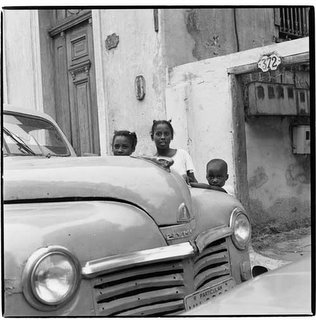 I made this photo walking around in Cerro one Saturday morning several years ago. All three kids were playing in the street. I started talking to them, they were not afraid of me, but they were a bit put off by a camera on a tripod. I have found that in Cuba taking pictures is as an excellent way to get to know folks. Most have no objection, many even like to have pictures made, especially if you can give them one. I use a polaroid back to do this. Occasionally someone will want to be paid. I understand this, but don't do it. This sort of thing has become more widespread in the past few years as the number of tourists has increased. I have on occasion hired models and of course l paid them for their time and effort. In this photo, the old car is more of a prop than the subject. I like that, although I have seen photos of the old cars that were beautiful "car pictures."
I made this photo walking around in Cerro one Saturday morning several years ago. All three kids were playing in the street. I started talking to them, they were not afraid of me, but they were a bit put off by a camera on a tripod. I have found that in Cuba taking pictures is as an excellent way to get to know folks. Most have no objection, many even like to have pictures made, especially if you can give them one. I use a polaroid back to do this. Occasionally someone will want to be paid. I understand this, but don't do it. This sort of thing has become more widespread in the past few years as the number of tourists has increased. I have on occasion hired models and of course l paid them for their time and effort. In this photo, the old car is more of a prop than the subject. I like that, although I have seen photos of the old cars that were beautiful "car pictures."
Sunday, January 29, 2006
Dominos
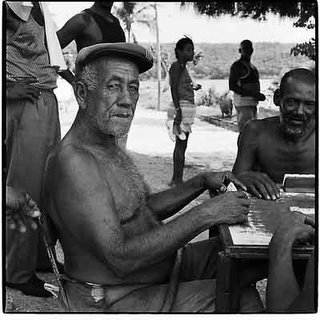 One hot June afternoon, I went to Cayo Granma. This small island is in the bay just out from Santiago. Under the shade of a large tree, an intense domino match was being played. I watched the games for about an hour. After a while I had just sort of blended in to the group. When I began to take a few pictures this man turned to stare. Soon the intensity of the game resumed and I clicked away with all the players oblivious to me and my camera. One can find dominos being played everywhere. Each village, on the sidewalks in the towns and cities, in parks, and in vacant lots. And, it's not the game of old men. Once you start to think that, you come upon a young person playing ferociously.
One hot June afternoon, I went to Cayo Granma. This small island is in the bay just out from Santiago. Under the shade of a large tree, an intense domino match was being played. I watched the games for about an hour. After a while I had just sort of blended in to the group. When I began to take a few pictures this man turned to stare. Soon the intensity of the game resumed and I clicked away with all the players oblivious to me and my camera. One can find dominos being played everywhere. Each village, on the sidewalks in the towns and cities, in parks, and in vacant lots. And, it's not the game of old men. Once you start to think that, you come upon a young person playing ferociously.
Saturday, January 28, 2006
Construction
 These fellows are working in Havana Vieja restoring a building. Many buildings have been restored and are used as shops, museums, galleries, and restaurants. The work proceeds slowly as does most everything. One can see the same slow transformation occurring in many of the older buildings along the Malecon. The entire city is so decrepit and the infrastructure so run down it will take millions of dollars and years to restore it to its former condition when Havana was generally considered one of the most beautiful cities in the world.
These fellows are working in Havana Vieja restoring a building. Many buildings have been restored and are used as shops, museums, galleries, and restaurants. The work proceeds slowly as does most everything. One can see the same slow transformation occurring in many of the older buildings along the Malecon. The entire city is so decrepit and the infrastructure so run down it will take millions of dollars and years to restore it to its former condition when Havana was generally considered one of the most beautiful cities in the world.
Friday, January 27, 2006
Tamara
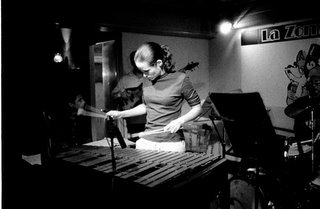 Tamara is a spectacular vibraphone player. She is in her early twenties and is extraordinarily accomplished. She and a group of young musicians were playing with a jazz trio of elderly musicians one night at La Zorro y El Cuervo in Vedado. This is a traditional jazz cellar frequented by local musicians and music lovers. The mix of ages and skills was wonderful. One could almost see the torch being passed from one generation to the next. The Cuban people are by their nature attracted to the arts. It provides some respite from the difficulties of day to day life and is just plain fun for all.
Tamara is a spectacular vibraphone player. She is in her early twenties and is extraordinarily accomplished. She and a group of young musicians were playing with a jazz trio of elderly musicians one night at La Zorro y El Cuervo in Vedado. This is a traditional jazz cellar frequented by local musicians and music lovers. The mix of ages and skills was wonderful. One could almost see the torch being passed from one generation to the next. The Cuban people are by their nature attracted to the arts. It provides some respite from the difficulties of day to day life and is just plain fun for all.
Thursday, January 26, 2006
Fishing
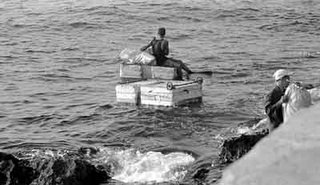 These men are headed out to sea on a fishing trip. They will go out this afternoon, fish all night and then head back sometime tomorrow. These rafts are fashioned from styrofoam and wood packing cases. The fish will be sold if they have a decent catch. This seems like a very dangerous way to scratch out a living, but many Cubans are very resourceful when it comes to rafts. Large inner tubes from truck tires ae also used. The boys and men who do this are called "pneumaticos."
These men are headed out to sea on a fishing trip. They will go out this afternoon, fish all night and then head back sometime tomorrow. These rafts are fashioned from styrofoam and wood packing cases. The fish will be sold if they have a decent catch. This seems like a very dangerous way to scratch out a living, but many Cubans are very resourceful when it comes to rafts. Large inner tubes from truck tires ae also used. The boys and men who do this are called "pneumaticos."
Wednesday, January 25, 2006
Tropicana
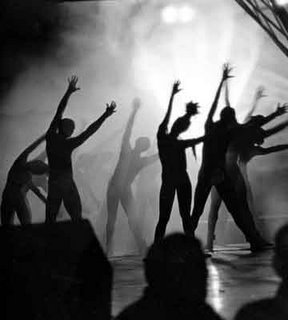 One definite connection with the past is the Tropicana night club. It is a wonderful show, a real extravaganza. The music is excellent and the dancers are superb. The night I went the crowd included tourists and Cubans. The night was beautiful, the tropical evening air refreshing. I recognize that the average Cuban today certainly can't afford the Tropicana, but then I can't afford tickets to The Producers on B'way either. Our second row Tropicana tickets were $75 each, and that included a bottle of rum, some Tropicola, and ice to sip during the show and a meal served during the intermission. Not a bad deal at all.
One definite connection with the past is the Tropicana night club. It is a wonderful show, a real extravaganza. The music is excellent and the dancers are superb. The night I went the crowd included tourists and Cubans. The night was beautiful, the tropical evening air refreshing. I recognize that the average Cuban today certainly can't afford the Tropicana, but then I can't afford tickets to The Producers on B'way either. Our second row Tropicana tickets were $75 each, and that included a bottle of rum, some Tropicola, and ice to sip during the show and a meal served during the intermission. Not a bad deal at all.
Tuesday, January 24, 2006
Machetero in Vinales
 This machetero was photographed at his home in the Viñales Valley. This has to be one of the most beautiful places in this hemisphere. The Royal Palms grow wild everywhere, the rolling hills studded with mogotes (huge rock formations) and the luxurious valleys are virtually unspoiled by development. This man was quite proud. He had his machete, his boots and hat-all sort of the uniform of the machetero. Unfortunately the sugar production has failed. Most of ingenios, refineries, are closed down, the machinery is rusting, and only a few are operational. Maintenance of the infrastructure has been a low priority of the revolutionary government and all pay the price for this neglect.
This machetero was photographed at his home in the Viñales Valley. This has to be one of the most beautiful places in this hemisphere. The Royal Palms grow wild everywhere, the rolling hills studded with mogotes (huge rock formations) and the luxurious valleys are virtually unspoiled by development. This man was quite proud. He had his machete, his boots and hat-all sort of the uniform of the machetero. Unfortunately the sugar production has failed. Most of ingenios, refineries, are closed down, the machinery is rusting, and only a few are operational. Maintenance of the infrastructure has been a low priority of the revolutionary government and all pay the price for this neglect.
Monday, January 23, 2006
Mas Pan
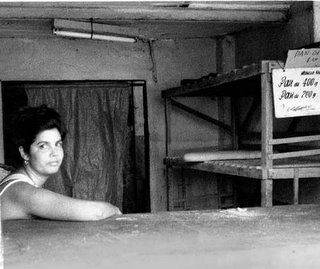 This image captures a lot of what life is like for many Cubans. A totally bored person, keeping a shop that has one stale loaf of bread. There are so many reasons for this situation that it almost defies understanding. For many there is only one reason-Fidel Castro. For others, there is the embargo (yet we are shipping and selling wheat to Cuba.) The tourism is also a reason-most of the decent foodstuff is earmarked for the fancier hotels where the average Cuban can't afford to go. The bottom line, as stated earlier, is that the economy has failed and it benefits those in power to keep the population impoverished and struggling. It has failed just as the economies of Eastern Europe and the USSR failed. Communism is not a workable system unless it is imposed by force.
This image captures a lot of what life is like for many Cubans. A totally bored person, keeping a shop that has one stale loaf of bread. There are so many reasons for this situation that it almost defies understanding. For many there is only one reason-Fidel Castro. For others, there is the embargo (yet we are shipping and selling wheat to Cuba.) The tourism is also a reason-most of the decent foodstuff is earmarked for the fancier hotels where the average Cuban can't afford to go. The bottom line, as stated earlier, is that the economy has failed and it benefits those in power to keep the population impoverished and struggling. It has failed just as the economies of Eastern Europe and the USSR failed. Communism is not a workable system unless it is imposed by force.
Sunday, January 22, 2006
Derrumbe!
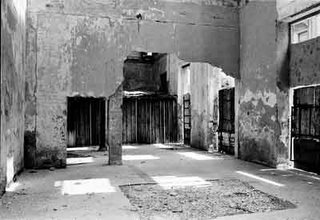 Derrumbé! Then there is a crash. Another building has collapsed. The older buildings in many of Cuba's cities are decaying as a consequence of the harsh tropical weather and lack of maintenance. There are vacant lots sprouting up all around. In Habana Vieja there is construction. There is some money from the UN, that area having been named a "World Heritage Site." The work moves slowly due to lack of materials and a lack of effort. The unfortunate truth is that most workers make less in a month, than a construction worker makes in a single day in the US. Once Cuba opens up it will take considerable time and money to restore it to the once vibrant country it was.
Derrumbé! Then there is a crash. Another building has collapsed. The older buildings in many of Cuba's cities are decaying as a consequence of the harsh tropical weather and lack of maintenance. There are vacant lots sprouting up all around. In Habana Vieja there is construction. There is some money from the UN, that area having been named a "World Heritage Site." The work moves slowly due to lack of materials and a lack of effort. The unfortunate truth is that most workers make less in a month, than a construction worker makes in a single day in the US. Once Cuba opens up it will take considerable time and money to restore it to the once vibrant country it was.
Saturday, January 21, 2006
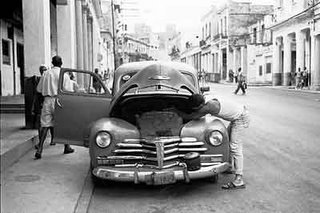 Unfortunately there are no "shade trees" in Havana under which to work on your car. Instead, one sees guys working on the streetside. They put the car up on blocks, work under it, work on the engine, drop out the transmission, just about any major thing one can imagine gets done curbside. Parts are rare and expensive. Each time I go, I get requests for spark plugs, various wires, brake pads, replacement light bulbs and that sort of thing. I usually throw in a pair or two of fuzzy dice and some Nascar caps which are popular. Smart people meeting most of their challlenges. PS_The Cuban baseball team got the visa to play in the international baseball tournament, common sense prevailed! Hopefully that's a start.
Unfortunately there are no "shade trees" in Havana under which to work on your car. Instead, one sees guys working on the streetside. They put the car up on blocks, work under it, work on the engine, drop out the transmission, just about any major thing one can imagine gets done curbside. Parts are rare and expensive. Each time I go, I get requests for spark plugs, various wires, brake pads, replacement light bulbs and that sort of thing. I usually throw in a pair or two of fuzzy dice and some Nascar caps which are popular. Smart people meeting most of their challlenges. PS_The Cuban baseball team got the visa to play in the international baseball tournament, common sense prevailed! Hopefully that's a start.
Thursday, January 19, 2006
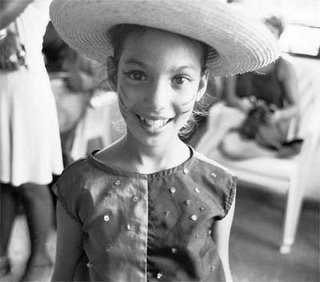 My friend, Robert, and his wife, Maria, are practitioners of Santeria. Roberto is aspiring to become a babalao and Maria teaches Afro-Cuban Folkloric dancing. The dance class is drawn from their neighborhood. One afternoon the group had a recital for us. All ages of kids, mainly young girls, danced. Ellington, their son, and one of his buddies banged on conga and bongo drums. Roberto played the suitcase, it had a nice bass sound. This little girl danced her heart out and her legs off in the role of Ellagua, a spirited orisha in the legends of Santeria. So many people came to the small community center we went out to the street and blocked it off. A policeman came and went down to the corner to deflect any traffic rather than close us down. Among the people there is little oppression, if you deal with the government, that's a totally different story.
My friend, Robert, and his wife, Maria, are practitioners of Santeria. Roberto is aspiring to become a babalao and Maria teaches Afro-Cuban Folkloric dancing. The dance class is drawn from their neighborhood. One afternoon the group had a recital for us. All ages of kids, mainly young girls, danced. Ellington, their son, and one of his buddies banged on conga and bongo drums. Roberto played the suitcase, it had a nice bass sound. This little girl danced her heart out and her legs off in the role of Ellagua, a spirited orisha in the legends of Santeria. So many people came to the small community center we went out to the street and blocked it off. A policeman came and went down to the corner to deflect any traffic rather than close us down. Among the people there is little oppression, if you deal with the government, that's a totally different story.
Wednesday, January 18, 2006
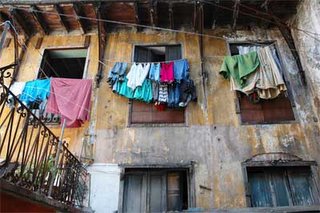 Laundry seems to be done every day. It is always hung out to dry for the average Cuban family certainly does not have a clothes dryer. The laundry flaps in the breeze like pennants of flags hung from the fronts of the old buildings. It can at times be quite colorful. It is almost a morning ritual to see women out hanging the laundry on lines strung across their patios. Most Cubans are extremely fastidious about their appearnace and cleanliness.
Laundry seems to be done every day. It is always hung out to dry for the average Cuban family certainly does not have a clothes dryer. The laundry flaps in the breeze like pennants of flags hung from the fronts of the old buildings. It can at times be quite colorful. It is almost a morning ritual to see women out hanging the laundry on lines strung across their patios. Most Cubans are extremely fastidious about their appearnace and cleanliness.
Tuesday, January 17, 2006
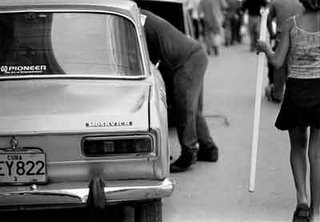 This Moskavich is a cheap version of an old Fiat, and that is going some, since the old Fiat was a generally cheap car. They are still all over the place in Havana. They are used as small taxis, private transportation, and they keep chugging along. This a typical scene on Lealtad, the street where I stay in H. Centro. It amazes me how ingenious the people are keeping all the ancient cars running and repaired. Many parts are either handmade or parts of slight similarity are modified so that they will work. There are no safety inspections or emissions testing done in Cuba and city air is full of fumes from the cars, trucks, and buses.
This Moskavich is a cheap version of an old Fiat, and that is going some, since the old Fiat was a generally cheap car. They are still all over the place in Havana. They are used as small taxis, private transportation, and they keep chugging along. This a typical scene on Lealtad, the street where I stay in H. Centro. It amazes me how ingenious the people are keeping all the ancient cars running and repaired. Many parts are either handmade or parts of slight similarity are modified so that they will work. There are no safety inspections or emissions testing done in Cuba and city air is full of fumes from the cars, trucks, and buses.
Monday, January 16, 2006
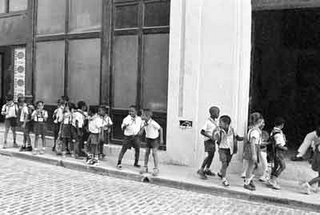 During the day one sees groups of school kids walking from one place to another. They often can be seen with their teachers having a class in a park or Plaza. Access to education was one of the early goals of the Revolution. Outside of the upper middle class families in the larger towns and cities, education was quite spotty in the 1940s and 50s. The literacy rate was about 40-45%. After the Revolution many teachers were educated and dispatched to the more rural areas. Now every small village has a school. Access to higher education and vocational training are also available. Unfortunately there are not many jobs available for these educated young people because of the economic failures of the revolutionary government. One of my friends was an English teacher. She decided to to do something else, she was not allowed to being told teachers were a critical need and if she wanted to work that is what she had to do. She was being paid $15-20/month. Now she works as a guide and a fine art photographer. If she sells one photo to a tourist a month, she will make what she would otherwise make in a year. It is very difficult because most photographic supples have to be purchased on the black market.
During the day one sees groups of school kids walking from one place to another. They often can be seen with their teachers having a class in a park or Plaza. Access to education was one of the early goals of the Revolution. Outside of the upper middle class families in the larger towns and cities, education was quite spotty in the 1940s and 50s. The literacy rate was about 40-45%. After the Revolution many teachers were educated and dispatched to the more rural areas. Now every small village has a school. Access to higher education and vocational training are also available. Unfortunately there are not many jobs available for these educated young people because of the economic failures of the revolutionary government. One of my friends was an English teacher. She decided to to do something else, she was not allowed to being told teachers were a critical need and if she wanted to work that is what she had to do. She was being paid $15-20/month. Now she works as a guide and a fine art photographer. If she sells one photo to a tourist a month, she will make what she would otherwise make in a year. It is very difficult because most photographic supples have to be purchased on the black market.
Sunday, January 15, 2006
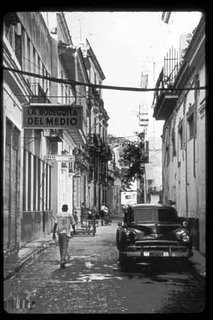 A typical street with a famous café. This restaurant is full of tourists most of the time. The old Chevrolet has been parked there each time I've walked past. I don't know if it is running or not, it may just be part of the tourist ambiance. Walking in the streets of Habana Vieja and Centro is my favorite thing to do in Havana. The constant sound of music; the smells of food cooking, leaking plumbing, cigar smoke, and the fumes of buses and cars all mixed together; the laughter of children playing; the people sitting in the doors arguing sports and politics; the slap of dominos on a worn out table; it is genuinely a confection of life.
A typical street with a famous café. This restaurant is full of tourists most of the time. The old Chevrolet has been parked there each time I've walked past. I don't know if it is running or not, it may just be part of the tourist ambiance. Walking in the streets of Habana Vieja and Centro is my favorite thing to do in Havana. The constant sound of music; the smells of food cooking, leaking plumbing, cigar smoke, and the fumes of buses and cars all mixed together; the laughter of children playing; the people sitting in the doors arguing sports and politics; the slap of dominos on a worn out table; it is genuinely a confection of life.
Saturday, January 14, 2006
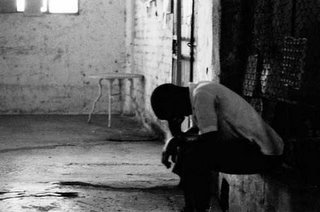 "La Lucha" For many in Cuba, life is a struggle. This bedraggled fellow was working in the meat department on the second floor of the "Free Market" in Cerro. He was just sitting there, in the near darkness, holding his head in his hands. This scene is repeated daily throughout the Carribbean and Latin America where the support of capitalism and "democracy" has created a small wealthy class in each country with a huge, exploited lower class. One place that has tried to avoid this is Cuba where most of the political leaders have not had amassing wealth as their goal. In Cuba the economy has failed for all, some of this is due to the embargo, some of it is the wasting of Cuban capital in the overzealous effort to export socialsm and revolution during the 70s and 80s, and some of it is the lack of incentives given to those who do produce. Hopefully some form of social democracy will evolve which will accomplish a blend of these goals. Che's dream of the "perfect man" remains just that, a dream.
"La Lucha" For many in Cuba, life is a struggle. This bedraggled fellow was working in the meat department on the second floor of the "Free Market" in Cerro. He was just sitting there, in the near darkness, holding his head in his hands. This scene is repeated daily throughout the Carribbean and Latin America where the support of capitalism and "democracy" has created a small wealthy class in each country with a huge, exploited lower class. One place that has tried to avoid this is Cuba where most of the political leaders have not had amassing wealth as their goal. In Cuba the economy has failed for all, some of this is due to the embargo, some of it is the wasting of Cuban capital in the overzealous effort to export socialsm and revolution during the 70s and 80s, and some of it is the lack of incentives given to those who do produce. Hopefully some form of social democracy will evolve which will accomplish a blend of these goals. Che's dream of the "perfect man" remains just that, a dream.
Wednesday, January 11, 2006
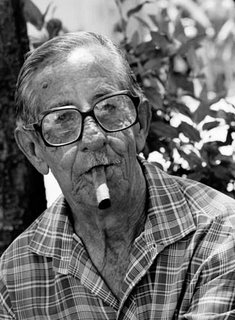 Almost all Cubans enjoy a good Cuban cigar. Almost constantly when walking in H. Vieja, one is approached by young men offering cigars."Hey man, you want cigar?" When I answer, "NO." They return with, "Why not?" I always tell them, "Bad heart trouble." They are then very apologetic and sorry for me. It is great sport. Once when I told someone "No;" they grabbed me by the arm and jerked me toward them yelling "Why?" I shouted "Donde estas policia?" and the hustler ran, unfortunately he ran into the policeman coming around the corner. I was sorry it had come to that. My only altercation in 6 months of being in Cuba.
Almost all Cubans enjoy a good Cuban cigar. Almost constantly when walking in H. Vieja, one is approached by young men offering cigars."Hey man, you want cigar?" When I answer, "NO." They return with, "Why not?" I always tell them, "Bad heart trouble." They are then very apologetic and sorry for me. It is great sport. Once when I told someone "No;" they grabbed me by the arm and jerked me toward them yelling "Why?" I shouted "Donde estas policia?" and the hustler ran, unfortunately he ran into the policeman coming around the corner. I was sorry it had come to that. My only altercation in 6 months of being in Cuba.
Tuesday, January 10, 2006
 As in many Caribbean and Latin American countries, much of life transpires on the street. This cobbler was set up for business across from the "Free Market" in Cerro. He always had business. Around the corner another man was in his front yard, he had an appliance junkyard and was selling used parts for refrigerators, washers, and stoves. Most Cubans are very capable and resourceful. They cooperate and assist one another. The sense of community and friendship between neighbors is quite strong.
As in many Caribbean and Latin American countries, much of life transpires on the street. This cobbler was set up for business across from the "Free Market" in Cerro. He always had business. Around the corner another man was in his front yard, he had an appliance junkyard and was selling used parts for refrigerators, washers, and stoves. Most Cubans are very capable and resourceful. They cooperate and assist one another. The sense of community and friendship between neighbors is quite strong.
Monday, January 09, 2006
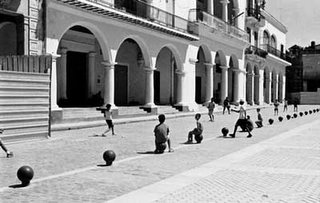 There was a good column in the New York Times yesterday regarding the international baseball tournament and the US's refusal to grant entrance visas to the athletes from Cuba. This is hardly the first time this has happened. Ranging from musicians to athletes to scholars to artists, Cubans have been refused entry even for a few days. The rationale offered is that this prevents US money from being accumulated by the "Castro regime." Baseball is almost sacred in Cuba. Fidle Castro had a try-out with the Cleveland Indians, had he a better fast ball history might have been considerably different. Everywhere one sees kids playing stickball. A piece of scrap lumber and a ball made of paper and then wound heavily with duct tape. If you should go to Cuba, throw i a couple of balls-rubber, baseballs, tennis balls whatever into your bag, you will make a good friend with such a simple thing.
There was a good column in the New York Times yesterday regarding the international baseball tournament and the US's refusal to grant entrance visas to the athletes from Cuba. This is hardly the first time this has happened. Ranging from musicians to athletes to scholars to artists, Cubans have been refused entry even for a few days. The rationale offered is that this prevents US money from being accumulated by the "Castro regime." Baseball is almost sacred in Cuba. Fidle Castro had a try-out with the Cleveland Indians, had he a better fast ball history might have been considerably different. Everywhere one sees kids playing stickball. A piece of scrap lumber and a ball made of paper and then wound heavily with duct tape. If you should go to Cuba, throw i a couple of balls-rubber, baseballs, tennis balls whatever into your bag, you will make a good friend with such a simple thing.
Saturday, January 07, 2006
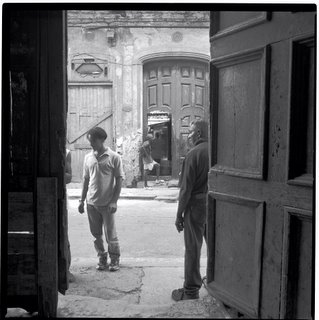 There are many old, decaying buildings in H. Vieja. They line the narrow streets. They mainly have been divided into apartments and often 4-5 different families live there. Sometimes the people are related, others not. Many have courtyards, others do not. The streets of Habana Vieja are full of people who are unemployed often standing about watching the work crews that are busy restoring the buildings. Over the paast 6 years, I have seen considerable improvement as buildings are being repaired. The architect of this work, Eusebio Leal, has a real vision for the restoration of may parts of Havana.
There are many old, decaying buildings in H. Vieja. They line the narrow streets. They mainly have been divided into apartments and often 4-5 different families live there. Sometimes the people are related, others not. Many have courtyards, others do not. The streets of Habana Vieja are full of people who are unemployed often standing about watching the work crews that are busy restoring the buildings. Over the paast 6 years, I have seen considerable improvement as buildings are being repaired. The architect of this work, Eusebio Leal, has a real vision for the restoration of may parts of Havana.
Friday, January 06, 2006
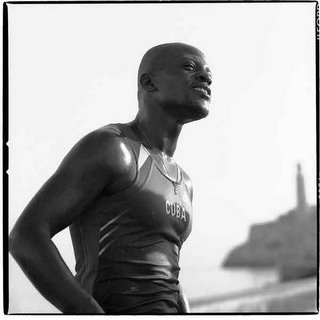 Israel is a runner. I met him a year or so ago. He was running along the Malecon early one morning. He has ambitions of being in the Olympics. I have no idea how that is going. He has a full time job and works out in his spare time. While sports are important to Cuba and its people, the facilities are quite limited and run down. There are none of the clean, orderly gleaming tracks, gyms, and aquatic facilities that we are used to in this country. After making his portrait I thanked him, wished him luck, and he ran off headed back toward Vedado.
Israel is a runner. I met him a year or so ago. He was running along the Malecon early one morning. He has ambitions of being in the Olympics. I have no idea how that is going. He has a full time job and works out in his spare time. While sports are important to Cuba and its people, the facilities are quite limited and run down. There are none of the clean, orderly gleaming tracks, gyms, and aquatic facilities that we are used to in this country. After making his portrait I thanked him, wished him luck, and he ran off headed back toward Vedado.
Thursday, January 05, 2006
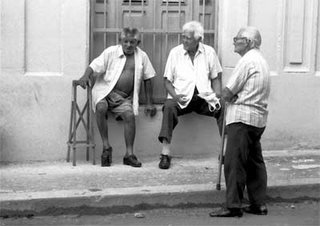 These fellows gather every day outside the house where I usually stay in Habana Centro. They spend the day talking and observing the scene. In the afternoon the kids who are home from school play in the street. If you give them a ball they will play for days it seems. They make up games, play stickball, and just throw it against the wall-like kids everywhere. Each of these men live with their children and grandchildren. The tradition of families caring for each other is quite strong in Cuba. Some of the older folks, especially the men who were in the Revolution or had jobs in the government, receive a "patrimony." In this neighborhood in Centro, not that many people go to work. Many stay home, some make their income renting rooms. My landlord, Tony, is a retired MD who makes more being the broker for both himself and neighbors in renting rooms with meals for about $25/night. He has a web site and when I am there I am constantly surprised by how many people show up looking for a place to stay. Mostly young European tourists and South American visitors.
These fellows gather every day outside the house where I usually stay in Habana Centro. They spend the day talking and observing the scene. In the afternoon the kids who are home from school play in the street. If you give them a ball they will play for days it seems. They make up games, play stickball, and just throw it against the wall-like kids everywhere. Each of these men live with their children and grandchildren. The tradition of families caring for each other is quite strong in Cuba. Some of the older folks, especially the men who were in the Revolution or had jobs in the government, receive a "patrimony." In this neighborhood in Centro, not that many people go to work. Many stay home, some make their income renting rooms. My landlord, Tony, is a retired MD who makes more being the broker for both himself and neighbors in renting rooms with meals for about $25/night. He has a web site and when I am there I am constantly surprised by how many people show up looking for a place to stay. Mostly young European tourists and South American visitors.
Wednesday, January 04, 2006
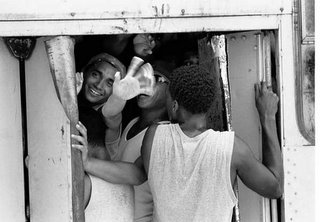 Crowding onto the "camello", the large truck pulled trailers that provide mass transit in Havana can be difficult, but sometimes it is just fun to be in the press of people. A friend told me that if you ride the camello long enough you will steal your own stuff back, the pick pockets being so prevalent. Another referred to a camello ride on Saturday night as "drugs, sex, and rock and roll!" Transportation is a problem throughout the country. In the country one sees people riding in the backs of farm trucks or on trailers pulled by old clap-trap tractors. In Cienfuegoes there are many horsedrawn wagons that provide public transportation. In Sancti Spiritus people ride standing in the backs of trucks. In Havana, there are taxis, buses, and the camellos. There are also bicitaxis, a sort of rickshaw bicycle arrangement, but those are mainly reeserved for the Cubans. The last two times I rode a bicitaxi, I was stopped and the driver was chastised for picking me up. Many of the older, classic cars have been nationalized to provide a sort of novel taxi service for the tourists. My favorite ride in Havana is the Cocotaxi, a seat in a yellow half shell pulled by a motor bike. This is great fun unless it rains!
Crowding onto the "camello", the large truck pulled trailers that provide mass transit in Havana can be difficult, but sometimes it is just fun to be in the press of people. A friend told me that if you ride the camello long enough you will steal your own stuff back, the pick pockets being so prevalent. Another referred to a camello ride on Saturday night as "drugs, sex, and rock and roll!" Transportation is a problem throughout the country. In the country one sees people riding in the backs of farm trucks or on trailers pulled by old clap-trap tractors. In Cienfuegoes there are many horsedrawn wagons that provide public transportation. In Sancti Spiritus people ride standing in the backs of trucks. In Havana, there are taxis, buses, and the camellos. There are also bicitaxis, a sort of rickshaw bicycle arrangement, but those are mainly reeserved for the Cubans. The last two times I rode a bicitaxi, I was stopped and the driver was chastised for picking me up. Many of the older, classic cars have been nationalized to provide a sort of novel taxi service for the tourists. My favorite ride in Havana is the Cocotaxi, a seat in a yellow half shell pulled by a motor bike. This is great fun unless it rains!
Monday, January 02, 2006
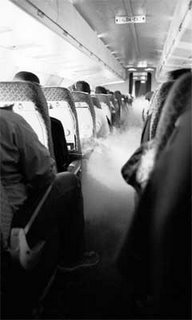 On the first workshop group I took to Cuba we flew through Nassau. Had enough free time to have conch fritters for lunch and then back to board our Air Cubana YAK-42, I think the 42 represented its age! There are no seat assignments, all the Cubans run to the plane to claim a "good seat." As a consequence, I was in the last row of the plane. It lumbered down the runway and just as the concrete was running out, it lifted off. The outside air and AC share the same ventilation system. As the plane descends to land, the hot humid tropical air rushes into the plane's cabin and immediately condenses because of the low temperature-it makes fog. It looks as if the entire fuselage is beginning to smoke! I knew about this, but it surely scared several of the students. All of them joined in with the Latin tradition of a round of applause after a good landing.
On the first workshop group I took to Cuba we flew through Nassau. Had enough free time to have conch fritters for lunch and then back to board our Air Cubana YAK-42, I think the 42 represented its age! There are no seat assignments, all the Cubans run to the plane to claim a "good seat." As a consequence, I was in the last row of the plane. It lumbered down the runway and just as the concrete was running out, it lifted off. The outside air and AC share the same ventilation system. As the plane descends to land, the hot humid tropical air rushes into the plane's cabin and immediately condenses because of the low temperature-it makes fog. It looks as if the entire fuselage is beginning to smoke! I knew about this, but it surely scared several of the students. All of them joined in with the Latin tradition of a round of applause after a good landing.
Subscribe to:
Posts (Atom)